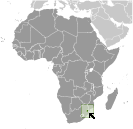World Atlas: Swaziland. On this page you can see the map, country flag and many detailed information about the people, history and economy of Swaziland.

Here you can find online selected information about the geography, inhabitants, government, economy and history of Swaziland. Included are selected statistics, an overview map and the detailed map of Swaziland. But let's start with the flag of Swaziland here:
Swaziland - Overview:
What you should know about Swaziland? Let's start with this: Autonomy for the Swazis of southern Africa was guaranteed by the British in the late 19th century; independence was granted in 1968. Student and labor unrest during the 1990s pressured King Mswati III, Africa's last absolute monarch, to grudgingly allow political reform and greater democracy, although he has backslid on these promises in recent years. A constitution came into effect in 2006, but the legal status of political parties was not defined and their status remains unclear. Swaziland has surpassed Botswana as the country with the world's highest known HIV/AIDS prevalence rate.
Geography of Swaziland
 Where on the globe is Swaziland? The location of this country is Southern Africa, between Mozambique and South Africa. Total area of Swaziland is 17,364 sq km, of which 17,204 sq km is land. So this is quite a small country. How could we describe the terrain of the country? This way: mostly mountains and hills; some moderately sloping plains. The lowest point of Swaziland is Great Usutu River 21 m, the highest point Emlembe 1,862 m. And the climate is varies from tropical to near temperate.
Where on the globe is Swaziland? The location of this country is Southern Africa, between Mozambique and South Africa. Total area of Swaziland is 17,364 sq km, of which 17,204 sq km is land. So this is quite a small country. How could we describe the terrain of the country? This way: mostly mountains and hills; some moderately sloping plains. The lowest point of Swaziland is Great Usutu River 21 m, the highest point Emlembe 1,862 m. And the climate is varies from tropical to near temperate.
Inhabitants of Swaziland
Let's take a look how many people live in Swaziland. The number is: 1,467,152. So not so many people live here. Who lives here? African 97%, European 3%. What are the languages in Swaziland? English (official, used for government business), siSwati (official). And the religions: Christian 90% (Zionist - a blend of Christianity and indigenous ancestral worship - 40%, Roman Catholic 20%, other 30% - includes Anglican, Methodist, Mormon, Jehovah's Witness), Muslim 2%, other 8% (includes Baha'i, Buddhist, Hindu, indigenous religionist, Jewish) (2015 est.). How old are the people in average? 21.7 years. We have to add that this number is the median - so one half of the people is older than this, one half is younger. And what is their life expectancy (at birth)? This: 52.1 years. Where the people live in Swaziland? Here: because of its mountainous terrain, the population distribution is uneven throughout the country, concentrating primarily in valleys and plains. The major urban areas of Swaziland are: Mbabane (capital) 66,000 (2014).
Government and Economy of Swaziland
The capital of Swaziland is Mbabane (administrative capital); Lobamba (royal and legislative capital) and the government type absolute monarchy. Let's take a look at the administrative divisions - 4 regions; Hhohho, Lubombo, Manzini, Shiselweni. Regarding the economy of Swaziland, important industrial products are soft drink concentrates, coal, forestry, sugar processing, textiles, and apparel. Important agricultural products are sugarcane, corn, cotton, citrus, pineapples, cattle, goats. The most important export commodities are soft drink concentrates, sugar, timber, cotton yarn, refrigerators, citrus, and canned fruit and the most important export partners are South Africa 87.1%, Namibia 4% (2016). The most important import commodities are motor vehicles, machinery, transport equipment, foodstuffs, petroleum products, chemicals and the most important import partners are South Africa 60.3%, China 5.3%, Mozambique 5.1% (2016). How rich is Swaziland and how rich are people in this country? The most important number here is GDP per capita (PPP): $9,900 (2017 est.). This is quite a low number. Let's add that this means Gross Domestic Product per person, which is recalculated with respect to the relative cost of local goods and services. And one more important number - population below poverty line: 63% (2010 est.).